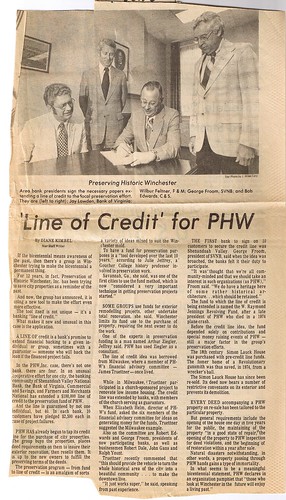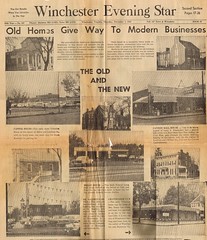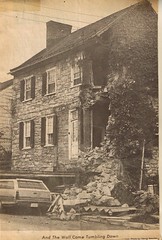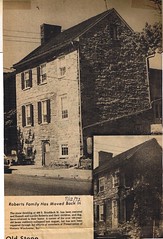The office will be closed due to inclement weather on Monday, March 3. Stay safe and warm, everyone!
The office will be closed due to inclement weather on Monday, March 3. Stay safe and warm, everyone!
Although the organization had attempted to acquire property for hands-on preservation through the 1960s and early 1970s, no purchases resulted from the attempts. That was to change in 1974 with the creation of the W. Raymond Jennings Revolving Fund.
Ray Jennings, mentioned previously as one of the best advocates for Winchester’s rich architectural heritage in the Feb. 7 post, was also one of the strongest advocates for the revolving fund idea in Winchester.(1) Such a fund’s purpose in a preservation-oriented organization would be to purchase, protect with covenants, and resell endangered property to new owners willing to undertake the renovation. Because of his experience traveling to other cities to learn from their preservation efforts, Ray Jennings had seen revolving funds in action and knew they could be powerful tools for historic preservation. Throughout his time in Winchester, he had worked tirelessly to see a revolving fund become a reality.
 His insistence bore fruit. He was president briefly in 1973-1974 before he had to relocate for his job, but in that short time of leadership, strategic plans were being put into place to pursue the idea of starting a Winchester revolving fund. The “Grand Event” in 1973 not only increased the membership threefold, but also put away a small starting nest egg for the fund. In 1974, the PHW leadership reorganized and created the position of revolving fund director for Betsy Helm.(2) Four lines of credit were opened at local banks, and the PHW board of directors led the pledge campaign to raise funds with each member contributing to the start up pool.(3) And last, PHW applied for several grants from the National Trust for Historic Preservation to help jump-start the effort.(4)
His insistence bore fruit. He was president briefly in 1973-1974 before he had to relocate for his job, but in that short time of leadership, strategic plans were being put into place to pursue the idea of starting a Winchester revolving fund. The “Grand Event” in 1973 not only increased the membership threefold, but also put away a small starting nest egg for the fund. In 1974, the PHW leadership reorganized and created the position of revolving fund director for Betsy Helm.(2) Four lines of credit were opened at local banks, and the PHW board of directors led the pledge campaign to raise funds with each member contributing to the start up pool.(3) And last, PHW applied for several grants from the National Trust for Historic Preservation to help jump-start the effort.(4)
Educational efforts (which will be covered more in depth in later posts) were launched in conjunction with the revolving fund in order to increase the awareness for the need to preserve our historic buildings. Speakers from major cities were brought in to conduct workshops and lectures on the revolving funds of Charleston, Savannah, Fredericksburg, and Pittsburgh.(5)(6)(7)(8) For the first time, PHW officially had an office to dedicate to these activities in the south wing of Betsy Helm’s home.
Ray Jennings had been scheduled to return and visit his friends in Winchester in September of 1974. He learned by telephone that the PHW revolving fund he had pushed for so strongly during his time here was soon to become a reality with a project building already in sale negotiations. It was to have been a happy reunion and a chance to catch up on the exciting changes at PHW, but tragedy struck. Ray had boarded the doomed Eastern Air Lines Flight 212 and did not survive the crash. (9)(10)
The news was devastating, but also served as a galvanizing force for PHW to succeed in the task of starting a revolving fund. Ray’s wife LouAnne requested that in lieu of memorials, donations should be made to PHW; the funds were put aside for the revolving fund. And most importantly, the fund itself was named in his honor so that we could all remember the good work he did during his four years in Winchester. His legacy is reflected in the nearly 80 properties overseen through the Jennings Revolving Fund, which keeps the memory and idealism of his activism alive and well forty years later.
Next week, we will learn about the all-important first revolving fund project – the Simon Lauck house on South Loudoun Street.
Information on the creation of the Jennings Revolving Fund in this post collected from oral history and unpublished speeches provided by Betsy Helm.
The Lunch and Learn Lecture on the Winchester National Register Historic District presented by Tim Youmans on Feb. 20, 2014 is available for viewing on YouTube. The presentation covers the update of the period of significance to the existing National Register Historic District in Winchester, VA, along with areas identified for inclusion in a future expansion of the National Register Historic District. Includes a test of “contributing” versus “non-contributing” structures and the Q&A session at the end of the presentation.
Watch the lecture on Youtube.
View the PDF version of the slides to better view the maps.
We often talk about our successes at PHW, but it’s important to remember that not every project or property we’ve set our sights on was able to be saved through our efforts. Here are a few “big fish” stories from 1963 to the early 1970s which did not bear fruit.
 Some of the demolished properties which initially concerned the nucleus of PHW in 1963 included Dr. Baldwin’s stone office and the Cannon Ball House on South Loudoun Street, the Capper House on North Loudoun Street, the Chanticleer Inn on West Boscawen Street, and the Hollis House on Cork Street. It appears that these properties were used as examples in the November 1963 meeting at the Handley Library, mentioned in passing in the January 24 post.
Some of the demolished properties which initially concerned the nucleus of PHW in 1963 included Dr. Baldwin’s stone office and the Cannon Ball House on South Loudoun Street, the Capper House on North Loudoun Street, the Chanticleer Inn on West Boscawen Street, and the Hollis House on Cork Street. It appears that these properties were used as examples in the November 1963 meeting at the Handley Library, mentioned in passing in the January 24 post.
Concurrent with the Conrad House, several other buildings were part of the public discussion on parking lots downtown. This included the old health building, the Firestone Building, and Valley Distributors at Braddock and Amherst Streets. The properties were consolidated by the Winchester Parking Authority and razed in 1966-1968, eventually becoming the Braddock Street Parking garage. PHW spoke out in particular for the old health building, even attempting the lease the building to prevent its demolition.(1)(2)(3)(4)
 Toward the end of the battle for the Conrad House, Hawthorn on Amherst Street was similarly being threatened with demolition for subdivisions for more Whittier Acres construction if the building could not be sold. Although PHW toyed with the idea of buying the property jointly with other civic organizations, the idea did not come to pass and the home was preserved through private efforts. Conrad House enthusiasts may be pleased to note the front porch now on Hawthorn was salvaged from the Conrad House.
Toward the end of the battle for the Conrad House, Hawthorn on Amherst Street was similarly being threatened with demolition for subdivisions for more Whittier Acres construction if the building could not be sold. Although PHW toyed with the idea of buying the property jointly with other civic organizations, the idea did not come to pass and the home was preserved through private efforts. Conrad House enthusiasts may be pleased to note the front porch now on Hawthorn was salvaged from the Conrad House.
Following the demolition of the Conrad House, efforts were made to purchase the small stone building then at 8 East Cork Street, often referred to as Friendship Market. That building, as well as several others, was for sale as part of the Sirbaugh Estate. However, the sellers had no desire to split up the package of properties and sell the stone building separately. PHW still managed to have a hand in that building’s preservation, which we will cover in a later post.(5)(6)
Also considered for purchase was the stone building at 15 South Braddock Street, as its location was no longer suitable for a dwelling and it could be adapted for office use.(7) Houses on Sharp Street were circled several times as being of interest to restore to provide more low-cost housing in the city and to retain for their historical and architectural value.(8) Properties on South Loudoun were also seen as potential purchases for similar restoration efforts. Word reached PHW about a possible City-led demolition of a log house at 502 1/2 South Cameron Street. None of the gentle inquiries or outright offers about purchasing these properties bore fruit.
Next week, however, we will learn how PHW became motivated to start a revolving fund and become serious about purchasing endangered properties.
John Barker, PHW’s president, was interviewed for WINC for the Preservation Virginia Economic Impact Study and how that relates to Winchester and Preservation of Historic Winchester. Catch the interview this Sunday on:
WINC-FM (92.5) Sunday morning around 5:45
WINC-AM (NewsTalk 1400) Sunday morning around 6:30
WINC-COUNTRY (B105) Sunday morning around 6:45
The interviews should also repeat next Sunday.
After some further consulting, the office will be closed again today due to the heavy snow. Stay safe and warm today, everyone, and we’ll be open as usual on Monday!
 The first successful preservation effort undertaken by PHW in the 1970s was the fundraising effort to save a vernacular limestone dwelling on South Braddock Street. According to Quarles’ The Story of One Hundred Homes in Winchester, Virginia, the house at 409 South Braddock Street was constructed circa 1835, most likely by William Lawrey, and subsequently had been owned for about 75 years by the Lawrey family heirs.
The first successful preservation effort undertaken by PHW in the 1970s was the fundraising effort to save a vernacular limestone dwelling on South Braddock Street. According to Quarles’ The Story of One Hundred Homes in Winchester, Virginia, the house at 409 South Braddock Street was constructed circa 1835, most likely by William Lawrey, and subsequently had been owned for about 75 years by the Lawrey family heirs.
By 1971 the home was in need of structural repairs. The owners, Russell and Lucy Roberts, had started the process to repair the building before the damage became too severe. They engaged a contractor to initiate repairs to the cracked northern wall. However, it was to be some time before the contractor finished a prior project and could start on their home.
The day before the contractor was to begin work on the Roberts’ family home, a significant portion of the northern wall collapsed, spilling the front porch, limestone blocks, and contents of the house onto the sidewalk and a station wagon parked on the street. Luckily, no one in the Roberts family was injured in the collapse and shoring up the building could begin almost immediately.(1)
 Because of PHW’s prior interest in the preservation of buildings like this around the downtown, a fundraising effort was able to be launched less than a week after the collapse, headed by Wilkie Hunt.(2) The $6,000.00 raised through the pledge drive and other unnamed PHW activities was loaned to the Roberts family for the reconstruction.(3)
Because of PHW’s prior interest in the preservation of buildings like this around the downtown, a fundraising effort was able to be launched less than a week after the collapse, headed by Wilkie Hunt.(2) The $6,000.00 raised through the pledge drive and other unnamed PHW activities was loaned to the Roberts family for the reconstruction.(3)
After about a year, the reconstruction efforts were complete and the Roberts family was able to return to their home.(4) The building remains one of Winchester’s excellent examples of local limestone construction with no hint of the disaster that once befell the property. It was tangible validation that preservation worked and the community was willing to financially back an appropriate effort. The much-discussed idea of purchasing buildings through a PHW-driven revolving fund to save them directly seemed like it could become a reality. The catch? Finding the right project, then buying it.
The PHW office will be closed Thursday, February 13 for inclement weather. You may continue to RSVP for the Feb. 20 Lunch and Learn lecture.
PHW invites you to our first “Lunch and Learn” lecture of 2014 with Tim Youmans, Director of Planning for the City of Winchester. The presentation will address the changes coming to the Winchester National Register Historic District by updating the period of significance and the possible expansion of the National Register Historic District.
Date: February 20, 2014
Time: Noon-1 p.m.
Location: June Jeffries Educational Center at the upper parking lot of the Lewis-Jones Knitting Mill, 126 N. Kent Street, Winchester, VA
RSVP: Appreciated but not required
Cost: Free, unless you reserve a boxed lunch through PHW
Lunch: Bring your own lunch or pre-order a Panera boxed lunch by 5 p.m. on Feb. 19
Questions? Contact PHW at phwi@verizon.net or 540-667-3577.
If you are unable to attend the meeting in person but are still interested in learning about the changes to the Historic District, a video of the event will be posted to PHW’s YouTube account.
Lunch reservations are now closed. Thank you!